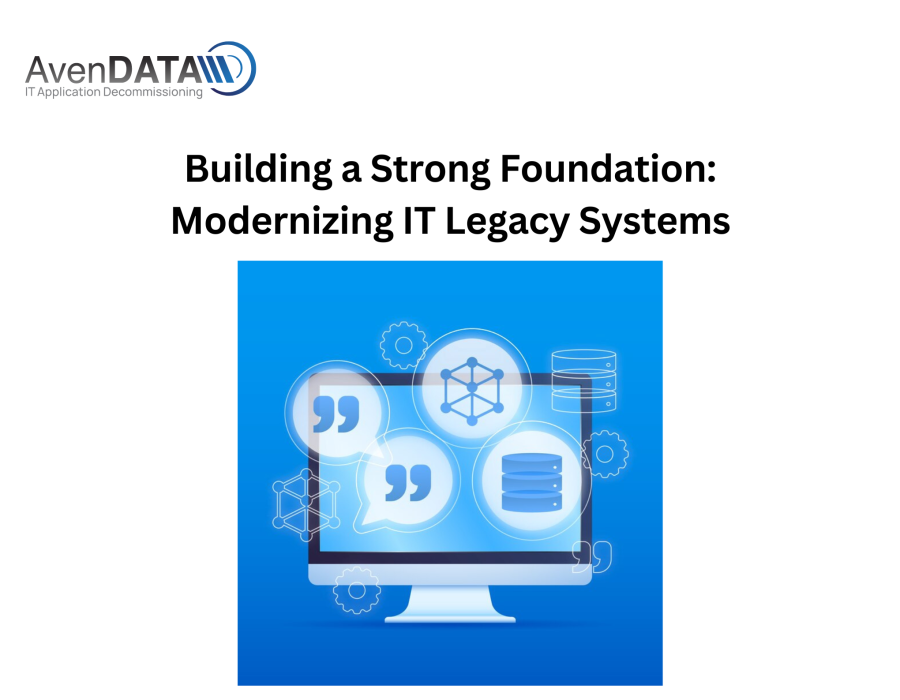Introduction: In today’s fast-paced and ever-evolving digital landscape, organizations face the challenge of staying competitive and agile while also managing their existing IT legacy systems. These legacy systems, often built on outdated technologies and architectures, can hinder innovation, scalability, and operational efficiency. However, by embracing modernization, organizations can build a strong foundation for their IT infrastructure, enabling them to adapt to changing market demands and unlock new opportunities. This blog explores the importance of modernizing IT legacy systems, the benefits it brings, and key strategies to successfully build a strong foundation for the future.
The Need for Modernization: Legacy systems, despite their years of service, can become a bottleneck to progress. Outdated technologies may lack the necessary security measures, fail to integrate with modern software, or impede collaboration and scalability. Modernizing IT legacy systems is crucial to overcome these challenges and ensure a robust foundation that can support business growth and innovation.
Enhancing Agility and Flexibility: Modernizing IT legacy systems empowers organizations to improve their agility and flexibility. By adopting modern technologies such as cloud computing, microservices, and containerization, organizations can embrace a more modular and scalable approach to IT infrastructure. This allows for faster development and deployment of applications, easier integration with third-party systems, and the ability to rapidly respond to changing market needs.
Cost Optimization and Efficiency: Legacy systems often require significant maintenance and support costs. By modernizing IT legacy systems, organizations can optimize their costs and improve operational efficiency. Modern technologies offer more cost-effective solutions, such as cloud-based infrastructure and software-as-a-service (SaaS) models, reducing the need for on-premises hardware and software maintenance.
Improved Security and Compliance: Legacy systems can pose security risks due to outdated security measures and vulnerabilities. Modernizing IT legacy systems allows organizations to implement robust security controls and stay compliant with industry regulations. This includes adopting encryption technologies, multi-factor authentication, and regular security updates to protect sensitive data and strengthen overall cybersecurity posture.
Enabling Innovation and Digital Transformation: Modernizing IT legacy systems is a stepping stone towards innovation and digital transformation. By adopting modern technologies, organizations can leverage emerging trends such as artificial intelligence, machine learning, and the Internet of Things (IoT). This enables them to uncover valuable insights, automate processes, and create new business models that drive growth and competitive advantage.
Streamlining Business Processes and Collaboration: Legacy systems often lack the integration capabilities required for streamlined business processes and collaboration. Modernizing IT legacy systems allows organizations to implement enterprise resource planning (ERP) systems, customer relationship management (CRM) platforms, and other business applications that enable seamless workflows and enhance collaboration across departments.
Change Management and User Adoption: Modernizing IT legacy systems requires effective change management and user adoption strategies. It is crucial to involve stakeholders from the beginning, communicate the benefits of modernization, and provide training and support to ensure smooth transition and user acceptance. User-centric design and intuitive interfaces can also facilitate a positive user experience, driving adoption and maximizing the benefits of modernized systems.
Conclusion: Building a strong foundation through modernizing IT legacy systems is a strategic imperative for organizations seeking to thrive in today’s digital landscape. By enhancing agility, reducing costs, improving security, enabling innovation, and streamlining business processes, organizations can unlock new opportunities and drive sustainable growth. Modernization is not just a technical endeavor; it requires a comprehensive approach that involves aligning business objectives with IT strategies, embracing change, and ensuring user adoption. With a modernized IT infrastructure, organizations can build a strong foundation that supports their long-term success and enables them to embrace future technologies with confidence.
#AvenDATA #legacysystems #ITlegacysystems #dataarchiving #legacydata






Comments